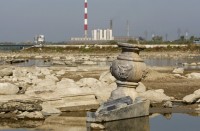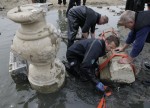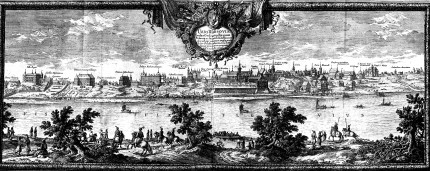 Water levels in the Vistula River in Warsaw, Poland, are at historic lows due to a long, hot summer of drought. Last week the water level measured at just 24 inches, the lowest it’s been since testing began in 1789. With the riverbed exposed, a treasure trove of 17th century architectural stonework has been revealed. Experts believe the large marble and alabaster pieces were looted from Warsaw’s Royal Castle during the Swedish invasion of the Polish-Lithuanian Commonwealth in 1655-60.
Water levels in the Vistula River in Warsaw, Poland, are at historic lows due to a long, hot summer of drought. Last week the water level measured at just 24 inches, the lowest it’s been since testing began in 1789. With the riverbed exposed, a treasure trove of 17th century architectural stonework has been revealed. Experts believe the large marble and alabaster pieces were looted from Warsaw’s Royal Castle during the Swedish invasion of the Polish-Lithuanian Commonwealth in 1655-60.
The period is known as The Deluge because of the vast devastation wreaked by the Swedish army. Poland’s cultural heritage was of particular interest to the Sweden since profit was one of the main motivations for the invasion. Churches, mansions, palaces and castles were stripped of any contents of value — jewels, clothing, paintings, tapestries, carpets, furnishings, statues, porcelain, religious relics, historical archives, books, manuscripts — and once they took everything that wasn’t nailed down, they moved on to the stuff that was. Floors, columns, decorative friezes, fountains, steps, door frames, doors, window casings, mantelpieces, chimneys, gates, were looted from Poland and Lithuania’s historic buildings.
Warsaw, replete with palaces, was particularly hard-hit having been sacked no less than three times during the war. The Royal Castle was so devastated that it had to be completely rebuilt in the last two decades of the 17th century.
Swedish troops loaded the booty onto barges and floated it up the Vistula to Gdansk where it was loaded onto ships which carried it on the short journey over the Baltic Sea to Sweden. Not all of the boats made it to their destination. Some of them, probably due to overloading from the literal tons of building parts they were carrying, sank on the Vistula before they even got out of Warsaw.
In 2009, the University of Warsaw led an interdisciplinary study of the spoil ships, searching historical maps, archives, libraries for references to treasure at the bottom of the river. They found several references to cargo tumbling off the boats into the river and to overloaded barges sinking in the Vistula in 1655 and 1656. They also researched news articles from 1906 reporting that sand barge operators on the 517th kilometer of the Vistula had found a number of large stone monuments on the bottom of the river. They were able to recover some of them from the riverbed and give them to museums in Warsaw. One marble sculpture looted from garden of Kazimierz Palace was returned to the reconstructed Kazimierz Palace, now the seat of Warsaw University.
 Although the sand barge operators said that there was more to be recovered, including one massive marble eagle which fell back into the water when the rope snapped during their attempt to raise it, there were no further attempts to recover the looted treasure for the next century. The University of Warsaw research team spent the rest of 2009 and the first half of 2010 scanning the river with state-of-the-art sonar, side-scan sonar and sub-bottom profilers to measure the riverbed and create a detailed grid map. They found several anomalies to investigate.
Although the sand barge operators said that there was more to be recovered, including one massive marble eagle which fell back into the water when the rope snapped during their attempt to raise it, there were no further attempts to recover the looted treasure for the next century. The University of Warsaw research team spent the rest of 2009 and the first half of 2010 scanning the river with state-of-the-art sonar, side-scan sonar and sub-bottom profilers to measure the riverbed and create a detailed grid map. They found several anomalies to investigate.
Unfortunately a deluge of the natural variety interrupted them. The Vistula flooded in late May and June of 2010, destroying many homes, drowning farmland and killing dozens of people. The recurring flood waters covered the riverbed with thick layers of silt and debris, obscuring the objects that had been detected. The waters remained high for the next few months, preventing any recovery efforts but allowing the team to do further research in areas that were previously to shallow for the ships to navigate.
 In 2011, the researchers enlisted diving teams to explore and excavate any artifacts they might find. Using barge-mounted cranes, they were able to recover a dozens of pieces of architectural stonework and sculptural elements, most importantly a marble triangle with the coat of arms of the Vasa family carved on its face. It dates to around 1610, and came either from the Royal Castle or the Kazimierz Palace. (If the name Vasa seems familiar, it’s because it’s the name of a famous Swedish warship so named after Sweden’s royal family at the time, a branch of which also ruled the Polish-Lithuanian Commonwealth when Sweden invaded).
In 2011, the researchers enlisted diving teams to explore and excavate any artifacts they might find. Using barge-mounted cranes, they were able to recover a dozens of pieces of architectural stonework and sculptural elements, most importantly a marble triangle with the coat of arms of the Vasa family carved on its face. It dates to around 1610, and came either from the Royal Castle or the Kazimierz Palace. (If the name Vasa seems familiar, it’s because it’s the name of a famous Swedish warship so named after Sweden’s royal family at the time, a branch of which also ruled the Polish-Lithuanian Commonwealth when Sweden invaded).
 After all that hard work, this summer another weather extreme has made side-scan sonar and sub-bottom profilers obsolete, and archaeologists have gladly taken advantage of the pendulum swing. Many of the artifacts have been recovered and are in storage awaiting conservation. Others will join them soon. In the meantime, police are patrolling the riverbank to keep looters from repeating history. The large size of many of the pieces makes casual looting unlikely, but determined ones will stop at nothing. It’s dangerous to attempt to walk on the riverbed. A mine from World War II has been discovered, and there could be all kinds of unexploded ordnance hidden in the mud.
After all that hard work, this summer another weather extreme has made side-scan sonar and sub-bottom profilers obsolete, and archaeologists have gladly taken advantage of the pendulum swing. Many of the artifacts have been recovered and are in storage awaiting conservation. Others will join them soon. In the meantime, police are patrolling the riverbank to keep looters from repeating history. The large size of many of the pieces makes casual looting unlikely, but determined ones will stop at nothing. It’s dangerous to attempt to walk on the riverbed. A mine from World War II has been discovered, and there could be all kinds of unexploded ordnance hidden in the mud.
 So far the artifacts are in surprisingly good condition despite having been violently detached from their original locations and then having spent 350 years under water. Their unwieldiness make them tricky to display, but they are invaluable to historians because between The Deluge and the many, many wars of conquest Poland suffered after that one, there is very little left in the historical record about the original Royal Castle. These pieces tell a dramatic story of how thoroughly the Swedish army plundered Warsaw, true, but they also provide priceless details about the construction of the castle.
So far the artifacts are in surprisingly good condition despite having been violently detached from their original locations and then having spent 350 years under water. Their unwieldiness make them tricky to display, but they are invaluable to historians because between The Deluge and the many, many wars of conquest Poland suffered after that one, there is very little left in the historical record about the original Royal Castle. These pieces tell a dramatic story of how thoroughly the Swedish army plundered Warsaw, true, but they also provide priceless details about the construction of the castle.
 More recent artifacts attesting to another dark chapter in Polish history have also been found in the shallow Vistula. Earlier this month Rafał Rachciński discovered a stone slab inscribed in Hebrew on a sandbar in the middle of the river. He reported the find to the press and archaeological authorities. When he returned a few days later with members of Virtual Shtetl, the web the portal of the Museum of the History of Polish Jews, they found more artifacts with Hebrew inscriptions.
More recent artifacts attesting to another dark chapter in Polish history have also been found in the shallow Vistula. Earlier this month Rafał Rachciński discovered a stone slab inscribed in Hebrew on a sandbar in the middle of the river. He reported the find to the press and archaeological authorities. When he returned a few days later with members of Virtual Shtetl, the web the portal of the Museum of the History of Polish Jews, they found more artifacts with Hebrew inscriptions.
They’re the remains of matzevots, Jewish headstones, which somehow made their way to center of the Vistula riverbed. Historians believe they may have come from Bródno Cemetery, the largest cemetery in Warsaw, which although Catholic has a section in the northeast reserved for people of other religions or no religion. It’s possible the headstones were destroyed during World War II and then used as fill to pave the riverbed after the war.
